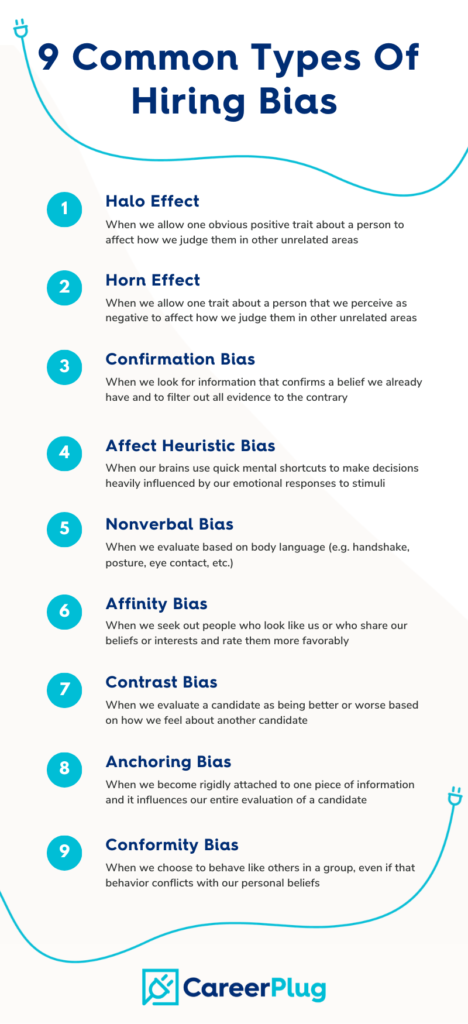Let’s start by acknowledging that everyone has unconscious bias — even you (yes, you). As humans, we are very social animals with complex brains that have evolved little mental shortcuts over thousands of years to help us make quick decisions. Unfortunately, in modern life, this can often lead to some flawed decisions in the form of unconscious bias.
In a hiring setting, unconscious bias can sabotage our efforts at recruiting and selecting the best candidates. By not being aware of the flawed shortcuts your brain makes, you could be missing out on a great hire. Worse, you could be weakening your team by bringing in a bad one.
In part one of this two-part blog series, you’ll learn how to become aware of the most common types of unconscious bias in hiring. In part two, you’ll learn some techniques to mitigate hiring bias across your organization.

1. Halo Effect
The halo effect is a cognitive bias in which we allow one obvious positive trait about a person to affect how we judge them in other unrelated areas. If a person is attractive, we might assume they’re also intelligent, kind, and funny. This single obvious positive trait serves as a kind of “halo” that causes people to make false assumptions about their abilities or personality.
Example
While reviewing resumes, you see that a candidate graduated from a prestigious university. You assume they must also be a great fit for your company. Other candidates match your ideal candidate profile better, but they graduated from public universities.
Without even realizing it, you may find yourself evaluating the Ivy Leaguer a little more easily than the others, ignoring any negative criteria that emerges throughout the hiring process. To prevent the halo effect in hiring, make sure you aren’t seeing correlations where there are none.
2. Horn Effect
This is the inverse of the halo effect. Rather than a “halo” bestowing positive attributes to a person, the “horns” are perceived negative attributes that cause you to jump to negative (and equally inaccurate) conclusions about a person. This hiring bias puts candidates at a significant disadvantage to overcome whatever the interviewer perceives as a negative quality.
Example
Let’s say you’re interviewing two candidates for an insurance agent role. One candidate is very athletic and the other is overweight.
A person’s physique has no bearing on their performance as an insurance agent. Yet the horn effect can subconsciously cause you to create inaccurate negative assumptions about the candidate who is overweight. Like the halo effect, this bias prevents you from making neutral, data-driven decisions.
3. Confirmation Bias
Confirmation bias has been called “the mother of all misconceptions.” And that’s a fitting title because confirmation bias affects you every single day. It’s the tendency to look for information that confirms a belief you already have and to subconsciously filter out all evidence to the contrary. This leads us to create flawed patterns in our thinking and can create bias in hiring.
Example
Consider business owner Joe, who is hiring for a management position and has two great candidates — one man and one woman. However, Joe believes that men are inherently better managers than women.
As a result, Joe might find himself looking for reasons to confirm his existing bias that he doesn’t think women can be good managers. This could cause him to overlook evidence that the female candidate might actually be a better fit with his ideal candidate profile than the male candidate.
Confirmation bias can be particularly dangerous when it involves making negative assumptions about groups of people that fall under the federally protected categories: religion, national origin, race, color, sex, age, and disability.
4. Affect Heuristic Bias
First of all, what does heuristic mean? Heuristics is the name given to a problem-solving approach in which a person uses mental shortcuts to produce a result that’s “good enough.”
“Affect” is a psychological term used to describe feelings or emotional responses. So, the affect heuristic bias is a cognitive bias that uses mental shortcuts to make decisions heavily influenced by emotions.
Research has shown that when you are in a positive emotional state, you are more likely to have a more positive, optimistic approach to making decisions. When you’re in a negative emotional state, you can perceive options as having fewer benefits and more risks.
When hiring, your quick emotional responses to certain things about a candidate can determine how you assess their risks and benefits. The affect heuristic bias causes insignificant factors to cloud our judgment.
Examples
In an interview, you notice that a candidate’s keychain has the logo of your favorite college football team. Your emotional response is quick and positive — you’ve decided in a split second that you like this person. You could spend the rest of the interview riding that initial, emotional wave of positive feelings.
Or consider a scenario in which you find a really great candidate who shares a name with someone you really dislike. Without even realizing it, you could find yourself in a bad mood when evaluating the candidate, causing you to assess them unfairly. To combat affect heuristic bias, make sure you’re making decisions by consulting the facts, not your feelings.
5. Nonverbal Bias
Nonverbal bias involves evaluating nonverbal communication, like body language, and giving it greater weight than we should. For example, there’s a longstanding belief that a strong handshake is a key to success and a weak handshake is a red flag.
But here’s the thing: you can teach someone how to have a stronger handshake pretty easily. It’s far more difficult to teach someone how to be a good fit for your company.
Examples
Some more common examples of nonverbal bias include judging a candidate based on their posture, eye contact, or facial expressions. Of course, you want to look holistically at a candidate and form your own opinions about them, and nonverbal communication is part of that. But because we all read nonverbal cues differently — and oftentimes, incorrectly — it’s best to stick to objective, measurable criteria to evaluate candidates.
6. Affinity Bias
Also known as the similarity bias, the affinity bias describes our natural tendency to get along with people who are like us. It’s easy for hiring managers to fall victim to affinity bias, especially when evaluating for culture fit.
Example
A few years ago, when CareerPlug was a small startup of about 20 employees, our workforce was primarily young, single, and (arguably) hip. As we grew, we began to attract candidates who were older and had families. Seeing the diversity of new candidates compared to our team allowed us to confront our own unconscious bias.
As a result, we had some long, thoughtful discussions about what “culture fit” means to us. We determined that a culture fit isn’t someone who looks like us or shares our backgrounds or interests. A culture fit is someone who is aligned with our company’s shared core values.
Our current workforce reflects our values and is more diverse than ever. Plus, as an added bonus: there’s plenty of evidence that proves diverse companies perform better.
Remember to always look to your company’s core values as the true north star when evaluating for culture fit. Make sure you don’t allow “culture fit” to become a code word for affinity bias.
7. Contrast Bias
Also known as contrast effect or judgment bias, this hiring bias causes us to believe that a candidate is better or worse based on how we feel about another candidate. This one is especially tough to avoid because it can be easy to forget that one candidate’s fitness for the role has nothing to do with another’s.
Example
Let’s say you’ve just wrapped up an interview with a candidate that went really well. If you fall victim to contrast bias, the rest of the candidates you interview that day may be at a disadvantage. Make sure you’re not comparing them to the first candidate, but rather your objective criteria for the role.
What about a candidate who has a terrible interview? They might suddenly elevate your opinion of other candidates who are merely mediocre. Remember: Don’t move the goalposts based on your experience with one candidate.
Of course, when making your final decision, you’ll need to weigh the benefits and risks of each person. But to prevent yourself from relying on feelings caused by contrast bias, make sure you’re always measuring by the same predetermined metrics. Using an applicant tracking system like CareerPlug can help you stick to measuring objective criteria using tools like prescreen questions and assessments. This allows you to evaluate all candidates consistently throughout the hiring process.
8. Anchoring Bias
Sometimes called expectation anchor bias, this is a trap we fall into when we have information that we become rigidly attached to. You can become anchored to the very first piece of information you receive about a candidate or your first impression of them in an interview. You can also become anchored to expectations that have nothing to do with the candidate, such as a precedent set by the previous person to hold the position.
Example
You’re hiring a replacement for Jane, your company’s current accountant. You create an ideal candidate profile based on Jane’s skills, experience, and other qualities. As a result, you become anchored to the expectation that the next accountant you hire will be exactly like Jane. What you’re looking for is another Jane, not another accountant.
When you become anchored to one piece of information, it causes you to assess other options less accurately — and you could end up missing out on recruiting some great talent.
9. Conformity Bias
Conformity bias refers to our tendency to behave like others in a group, even if that behavior conflicts with our personal beliefs. You probably recognize this cognitive bias in its more destructive form: peer pressure. In a hiring setting, however, you’ll want to ensure that you don’t allow the opinions of other stakeholders to sway your opinions about a candidate.
Example
Let’s say you’ve made up your mind about a candidate and were able to avoid all of the aforementioned confirmation biases. Great! But then when it comes time to debrief about the candidate, all the other interviewers have an opinion that differs from yours.
Once again, make sure that when you examine your conflicting opinions, you’re all measuring using the same metrics. If you’ve done everything right according to a structured hiring process, you shouldn’t change your score simply to match the group.
TLDR
- We all have unconscious bias, but the first step toward removing bias in hiring is to acknowledge it when it crops up.
- Measure every candidate using objective criteria to evaluate consistently and make better hiring decisions.
- Ignore information that has nothing to do with a candidate’s ability to perform the role, such as superficial traits.
In part two of this blog series, we’ll discuss techniques you can use to mitigate hiring bias across your organization. In the meantime, be sure to check out our Resources page for more insights from our Hiring Experts. And feel free to download this handy cheat sheet for future reference!

